Articles: Adoranten 2014
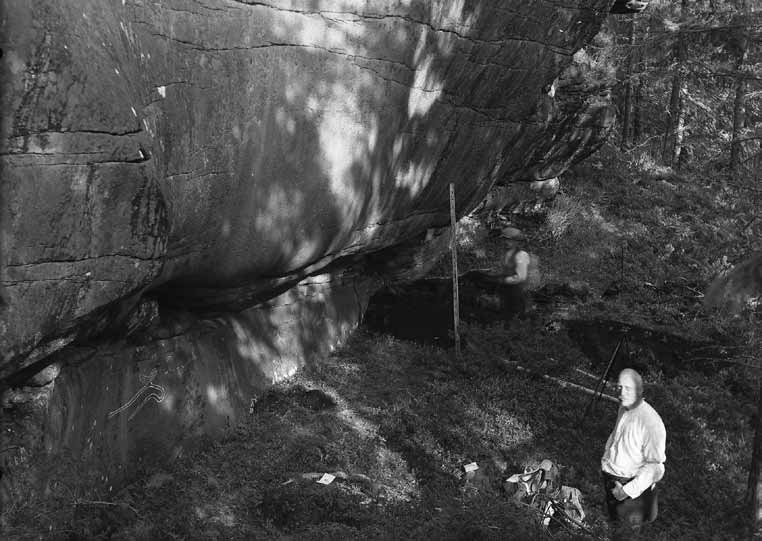 Two excavations conducted under rock-shelters containing rock art in the Trøndelag region, central Norway are presented. The first known excavation in front of rock art in this region, however, took place at Bardal Farm in Steinkjer, province of Nord-Trøndelag at the then recently discovered large panel today referred to as Bardal I, which is one of the largest rock-art panels known in the region. It is 29 metres long and 7-10 metres high, consisting of two sub-panels separated by a depression almost vertically crossing the rock. More than 350 rock carvings have been identified on this panel (Gjessing 1936, 196; Hallström 1938). These carvings seemingly represent a long timespan, from Late Mesolithic to Early Iron Age. Both Scandinavian rock art traditions are represented by several different motifs and the carvings frequently are involved in superimpositions.
Two excavations conducted under rock-shelters containing rock art in the Trøndelag region, central Norway are presented. The first known excavation in front of rock art in this region, however, took place at Bardal Farm in Steinkjer, province of Nord-Trøndelag at the then recently discovered large panel today referred to as Bardal I, which is one of the largest rock-art panels known in the region. It is 29 metres long and 7-10 metres high, consisting of two sub-panels separated by a depression almost vertically crossing the rock. More than 350 rock carvings have been identified on this panel (Gjessing 1936, 196; Hallström 1938). These carvings seemingly represent a long timespan, from Late Mesolithic to Early Iron Age. Both Scandinavian rock art traditions are represented by several different motifs and the carvings frequently are involved in superimpositions.
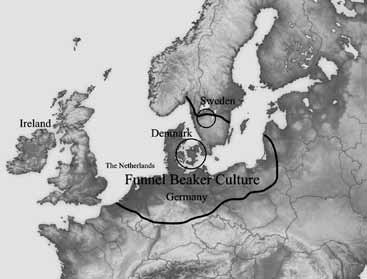 It could seem far-fetched to propose a cosmology in Neolithic time but it is never the less the subject of this paper. The hypothesis is that astronomical events could have had serious impact for the development of the culture during Neolithic times. Attention is given to the Funnel Beaker Culture (from about 4000 BC to about 2800 BC) in Northern Europe. Recent investigations of the overall layout of megalithic monument in Scandinavia concerning position and orientations show a complex pattern in clusters of megalithic monuments. The pattern in these structures could have been inspired by the behaviour of the rising full moon during the summer period. Following these patterns it is possible that the Neolithic people in Scandinavia learned to use the full moon as a lunar ‘season pointer’ and perhaps even found a way to use lunar eclipses in burial and ritual praxis. Some evidence is perhaps found in ancient literature and local names.
It could seem far-fetched to propose a cosmology in Neolithic time but it is never the less the subject of this paper. The hypothesis is that astronomical events could have had serious impact for the development of the culture during Neolithic times. Attention is given to the Funnel Beaker Culture (from about 4000 BC to about 2800 BC) in Northern Europe. Recent investigations of the overall layout of megalithic monument in Scandinavia concerning position and orientations show a complex pattern in clusters of megalithic monuments. The pattern in these structures could have been inspired by the behaviour of the rising full moon during the summer period. Following these patterns it is possible that the Neolithic people in Scandinavia learned to use the full moon as a lunar ‘season pointer’ and perhaps even found a way to use lunar eclipses in burial and ritual praxis. Some evidence is perhaps found in ancient literature and local names.
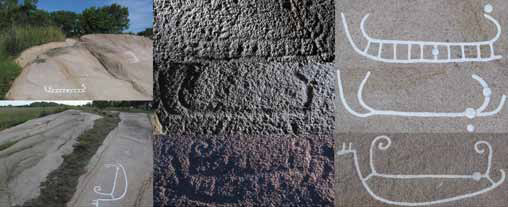 This article presents and discusses new discoveries and insights offered by recent rock art research carried out by staff and volunteers from Bornholms Museum during 2013 and 2014. Investigations have been carried out at numerous locations across the island using a variety of strategies and techniques. Searches for new rock art panels have been undertaken at a variety of locations. Soil has been removed from the area around certain known panels in order to find new carvings and investigate the archaeological context surrounding the rocks. New figures have been discovered on surfaces already registered with carvings, through the combination of evidence from night photography and the creation of 3D models, using the Structure from Motion technique. The searches for new carvings and, where appropriate, their surrounding archaeological context will be discussed by James Dodd, whilst technical questions concerning the application and results of the Structure from Motion models will be addressed within Manuel Dueñas’s contribution.
This article presents and discusses new discoveries and insights offered by recent rock art research carried out by staff and volunteers from Bornholms Museum during 2013 and 2014. Investigations have been carried out at numerous locations across the island using a variety of strategies and techniques. Searches for new rock art panels have been undertaken at a variety of locations. Soil has been removed from the area around certain known panels in order to find new carvings and investigate the archaeological context surrounding the rocks. New figures have been discovered on surfaces already registered with carvings, through the combination of evidence from night photography and the creation of 3D models, using the Structure from Motion technique. The searches for new carvings and, where appropriate, their surrounding archaeological context will be discussed by James Dodd, whilst technical questions concerning the application and results of the Structure from Motion models will be addressed within Manuel Dueñas’s contribution.
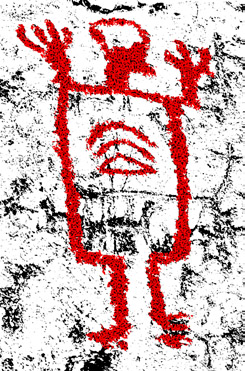 Although rock art images all over the world often narrate of life and death in ancient societies, representations of copulation, pregnancy, giving birth and – ultimately - death are relatively rather scarce. The situation in the Andes of South America is not different, and in particular when it concerns death, imagery is rare in Andean rock art. Although the ancient Andean peoples definitely will have known that inside the body of many zoomorphs – thus also humans - there is a hard skeleton that becomes exposed after the soft parts have decomposed, graphical representations of skeletons in ancient Andean records are extremely rare, both in absolute and relative terms.
Although rock art images all over the world often narrate of life and death in ancient societies, representations of copulation, pregnancy, giving birth and – ultimately - death are relatively rather scarce. The situation in the Andes of South America is not different, and in particular when it concerns death, imagery is rare in Andean rock art. Although the ancient Andean peoples definitely will have known that inside the body of many zoomorphs – thus also humans - there is a hard skeleton that becomes exposed after the soft parts have decomposed, graphical representations of skeletons in ancient Andean records are extremely rare, both in absolute and relative terms.
For instance, in their well-known (ceramic) art the ancient Moche society of northern Peru relatively frequently depicted ‘dead’ people as ‘dancing’ skeletons, or as ‘Death’ sacrificing animals in certain rituals. But in the rich rock art repertoire of northern Peru only two petroglyphs depicting skeleton-anthropomorphs have so far been recorded (Van Hoek 2012b: Figs 307 and 308) and most likely these two figures are not even of Moche origin, being situated in the Santa Valley, far inland.
 In this paper, we argue that Nordic Bronze Age rock art was influenced by certain European regions and networks, which supplied metal to Scandinavia, and that the local figurative repertoire replied to changing metal sources and networks in a distinct manner.
In this paper, we argue that Nordic Bronze Age rock art was influenced by certain European regions and networks, which supplied metal to Scandinavia, and that the local figurative repertoire replied to changing metal sources and networks in a distinct manner.
We attempt to exemplify this hypothesis by comparing rock art and other stylistic forms and features from different regions. However, an important precondition is new scientific evidence that shows that Scandinavian bronzes were produced with non-local copper and tin, predominantly of Mediterranean and northern Alpine origin.
The supply of copper and tin to southern Scandinavia increased significantly around 1600 BC, and after this date started rock art motifs to appear which depicts metals and equipment communicating personal status and non-domestic cosmopolitan features. First weapons, oxhide ingots, chariots and representations of the sun, and later armour and mirrors. These figurative features articulated exclusive ‘social codes’ or ‘core values’ which were shared over large parts of Europe.
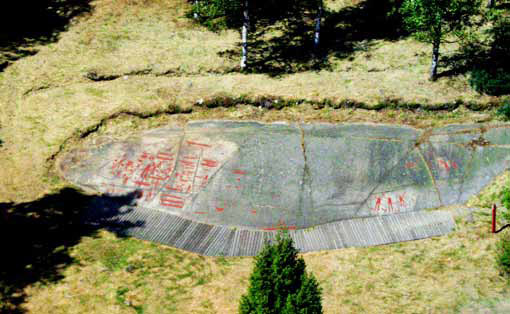 A review of how different authors have presented religious interpretations of Rock Art (RA) was partly presented in Kristian Kristiansens article in Adoranten 2012. To this group of more culture-historical oriented authors were Oscar Almgren who during the late 1920:s presented, to some extent, a revolutionary interpretation where he saw direct links between Babylonian and Egyptian traditions with Nordic RA, which he explained as a result of the expansion of agriculture and its cultural impact that was connected to this activity. […] Another aspect of interpretation that has been focused during more modern times is that the panels are connected to some sort of belief that was based upon travels to the world of death. Based upon the actual rock carvings that have been found inside graves as in Sagaholm, investigated by Joakim Goldhahn, it is not farfetched to connect these panels, where ships are presented, with the imagined travels of the soul from the dead person to an imagined place for dead. Linked to this theory of soul travels is also Fleming Kauls revolutionary scheme of the suns motion over the sky, based upon interpretations of motives made on Bronze Age razors, that links ships directions with pictures of animals to the position of the sun […] So the rock art can to some extent be linked to fertility, to death and to sun worship as indicated above, but probably also to other aspects of religious, not ordinary life.
A review of how different authors have presented religious interpretations of Rock Art (RA) was partly presented in Kristian Kristiansens article in Adoranten 2012. To this group of more culture-historical oriented authors were Oscar Almgren who during the late 1920:s presented, to some extent, a revolutionary interpretation where he saw direct links between Babylonian and Egyptian traditions with Nordic RA, which he explained as a result of the expansion of agriculture and its cultural impact that was connected to this activity. […] Another aspect of interpretation that has been focused during more modern times is that the panels are connected to some sort of belief that was based upon travels to the world of death. Based upon the actual rock carvings that have been found inside graves as in Sagaholm, investigated by Joakim Goldhahn, it is not farfetched to connect these panels, where ships are presented, with the imagined travels of the soul from the dead person to an imagined place for dead. Linked to this theory of soul travels is also Fleming Kauls revolutionary scheme of the suns motion over the sky, based upon interpretations of motives made on Bronze Age razors, that links ships directions with pictures of animals to the position of the sun […] So the rock art can to some extent be linked to fertility, to death and to sun worship as indicated above, but probably also to other aspects of religious, not ordinary life.
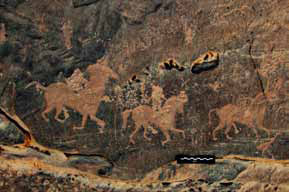 This research presents and discusses the history of rock art research in Tadrart Acacus which is a massif roughly 150 km long and 50 km wide. It is located north east part of Ghat in the Fezzan region Southwest part of Libya. It is also examines early and late rock art studies in North Africa and central Sahara that were investigated by a number of European travelers such as Heinrich Barth, Henry Duveyrier, Gustave Nachtegal, Ervin De Bary, Paolo Graziosi and then Mori and the Italian-Libyan archaeological mission in Acacus and Messak.
This research presents and discusses the history of rock art research in Tadrart Acacus which is a massif roughly 150 km long and 50 km wide. It is located north east part of Ghat in the Fezzan region Southwest part of Libya. It is also examines early and late rock art studies in North Africa and central Sahara that were investigated by a number of European travelers such as Heinrich Barth, Henry Duveyrier, Gustave Nachtegal, Ervin De Bary, Paolo Graziosi and then Mori and the Italian-Libyan archaeological mission in Acacus and Messak.
Tadrart Acacus is located north east part of Ghat about 150 km, and Tadrart Acacus is longitudinal shape located between 24-30 and 25-30 north of equator, east of it is Messak lands and Tanezzuft valley. Tadrart Acacus has thousands of cave paintings in very different styles these styles divided into five major periods: wild animals, round head period, pastoralist art, horse period, and camel period, dating from 12.000 B.C. to 100 C.E. In addition, there is numerous of rock art sites in Tadrart Acacus including hundreds of engravings and thousands of paintings.
 Bhimbetka, in the Raisen District of Madhya Pradesh, right in the middle of India, is the best-known rock art area in the sub-continent, so much so that it rated UNESCO’s World Heritage list in 2003. The Bhimbetka core area extends over 1892 hectares covering five hills within the Vindhyan Hills, named Vinayka, Bhonrawali, Bhimbetka, Lakhajuar east and Lakhajuar west. Only the Bhimbetka hill is easily accessible, and less than twenty painted shelters are daily opened to the public.
Bhimbetka, in the Raisen District of Madhya Pradesh, right in the middle of India, is the best-known rock art area in the sub-continent, so much so that it rated UNESCO’s World Heritage list in 2003. The Bhimbetka core area extends over 1892 hectares covering five hills within the Vindhyan Hills, named Vinayka, Bhonrawali, Bhimbetka, Lakhajuar east and Lakhajuar west. Only the Bhimbetka hill is easily accessible, and less than twenty painted shelters are daily opened to the public.
Despite their obvious importance, the Bhimbetka rock art sites did not attract scientific attention before 1957. Dr Vishnu Shridhar Wakankar, their discoverer, used to say that, when travelling along the hills on a train, he noticed the spectacular sandstone rock formations along the ridge. He got fascinated by them and by their surrounding landscape. He got down from the train to explore and he thus discovered Bhimbetka! From that momentous time, he started studying the numerous painted shelters and he never stopped until his death in 1988. He published articles, research papers and books in which the Bhimbetka rock art and its archaeological context played a major part.
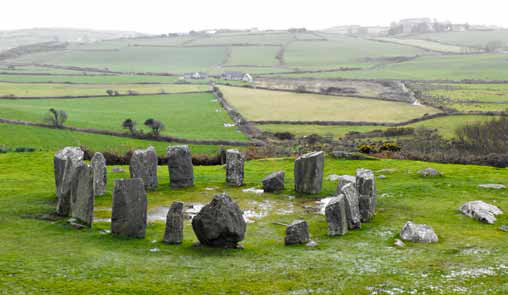 The largest group of stone circles in Europe is found in the southwestern region of Ireland. At least 90 circles survive today and it is known that originally there were at least as many as 108, the largest homogeneous group of stone circles yet discovered. They are also quite unique with some very special characteristics that may prove to be of great importance particularly in relation to the study of prehistoric astronomy.
The largest group of stone circles in Europe is found in the southwestern region of Ireland. At least 90 circles survive today and it is known that originally there were at least as many as 108, the largest homogeneous group of stone circles yet discovered. They are also quite unique with some very special characteristics that may prove to be of great importance particularly in relation to the study of prehistoric astronomy.
Known as the Cork/Kerry circles they have for a long time been recognized as a distinct group with clearly defined characteristics that set them apart from all other known circles. They constitute over a third of all the known stone circles in Ireland and half of all the circles in the southern Republic and are all situated within a radius of under 100 km in the far southwestern corner of Ireland.
 In Valcamonica there are no data growing quicker than the ones pertaining the Copper Age, a period that in the Alpine region covers roughly the end of the IV and the whole III millennium BC. A long and intense season of archaeological excavations has in fact started to change our perspective on this period, now crucially enriched by a close relationship between carved imagery and the primary context in which the figured stones were placed. Important conferences and exhibitions displayed recently some of the most significant novelties and, despite the still large unpublished materials, begun to offer new interesting insights to the increasingly rich and evermore fascinating iconography. At the same time the opening of the Museo Preistorico Nazionale della Vallecamonica (MUPRE) in Capo di Ponte in 2014 has made accessible some of these extraordinary findings in a new and captivating exhibit.
In Valcamonica there are no data growing quicker than the ones pertaining the Copper Age, a period that in the Alpine region covers roughly the end of the IV and the whole III millennium BC. A long and intense season of archaeological excavations has in fact started to change our perspective on this period, now crucially enriched by a close relationship between carved imagery and the primary context in which the figured stones were placed. Important conferences and exhibitions displayed recently some of the most significant novelties and, despite the still large unpublished materials, begun to offer new interesting insights to the increasingly rich and evermore fascinating iconography. At the same time the opening of the Museo Preistorico Nazionale della Vallecamonica (MUPRE) in Capo di Ponte in 2014 has made accessible some of these extraordinary findings in a new and captivating exhibit.
Due to the extent and complexity of the phenomenon, it is only possible here to offer a general updated overview, with a specific focus on the recent excavations, the specificity of some depicted subjects and the main lines of interpretations of the standing monoliths at the light of the current state of research.

|

